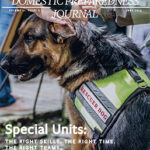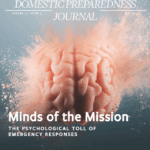In 2017, the city of Breda in the Netherlands struggled with organized crime. Gangs were illicitly tapping into electricity to sustain a clandestine marijuana cultivation operation, creating a significant fire hazard. Additionally, they were unlawfully obtaining access to apartments in low-income housing to store the marijuana. No single agency possessed the capacity to adequately address the matter, as a multitude of distinct city agencies had to be engaged to confront the organized crime enterprise. As a result, a multidisciplinary team (MDT) was established, comprising representatives from law enforcement, fire services, utility departments, housing authorities, and community stakeholders. Ultimately, the collaborative efforts of public and private agencies succeeded in dismantling the criminal operations of organized crime.
Since 2004, the U.S. Department of Justice has provided funding to support a multidisciplinary team (MDT) approach. In law enforcement, the MDT model represents a collaborative, cross-disciplinary group of professionals that leverages individual and organizational expertise to address multifaceted problems such as child abuse, human trafficking, elder abuse, sexual assault, domestic violence, and mental health crises, to name a few. Considering its diverse expertise, the MDT model can be highly effective in law enforcement operations as the Omaha Police Department in Nebraska discovered to target certain crimes, thus improving communication and case preparation. This “collective tactic” leads to a more comprehensive investigative approach, efficient resource utilization, and ultimately, better outcomes for victims and the legal system.
Designing a Multidisciplinary Team
An MDT can be conceptualized as a puzzle—if one piece is missing, the picture is not complete. If pieces are missing from MDTs, they fail to serve victims and survivors. MDTs can vary in model design based on an agency’s operational needs and the team focus (i.e., police, medical, social services, etc.). For this article, the MDT design concept is presented in the context of its utility within policing and investigations. Typically, law enforcement MDT task forces are categorized into four areas of function:
- Internal foundations, operations, and collaboration—The internal processes, protocols, systems, and initiatives that allow the task force’s operation as a cohesive unit. Although sometimes disregarded, they are crucial for the sustained success of a collaboration.
- Case operations—Functions pertaining to criminal investigations and prosecution, evidence collection, victim services, privacy, and referrals.
- Data, reporting, and assessment—Crime data analysis and evaluation to benefit an investigation and share information with team members.
- Public and community engagement—To facilitate change in these areas, public engagement often occurs beyond the scope of continuous task force collaboration. So, the immediate response by MDT has to also concentrate on the external efforts of the task force (i.e., community outreach, awareness, and training).
The inherent collaboration of an MDT (law enforcement model) especially benefits intricate cases or those involving vulnerable populations. This approach delivers a more thorough and efficient response than any one agency could accomplish independently.
Because of the specific disciplines MDTs bring together, a higher level of expertise benefits victim services and offender prosecution. Consequently, represented agencies work together to ensure a comprehensive and efficient investigation and response, minimizing duplication of efforts and potential re-traumatization of victims. Furthermore, the MDT approach has demonstrated better outcomes for victims and families, including increased identification of abuse cases, strengthened prosecution efforts, and improved access to support services for victims more quickly.
When working outside an MDT, agencies may discover roadblocks to communication between organizations. However, within an MDT, timely communication is better facilitated among members, often improving understanding of complex cases and better informing decision-making. Decisions regarding victims and perpetrators are made collectively, which ensures against “silos,” and takes into account all members’ perspectives, better prioritizing the victims’ best interests.
MDTs in Context
Collaboration among agencies can enhance their respective impact and streamline individual agency requirements. An MDT permits each agency to offer resources while sharing responsibility for investigating complex and varied cases. Following are MDT models that may be seen in law enforcement.
Human Trafficking MDT
In 2023, the National Human Trafficking Hotline answered a total of 30,162 calls nationwide and received reports of 9,619 potential human trafficking cases referencing 16,999 potential victims. The same year, the National Center for Missing and Exploited Children received over 18,400 reports of child sex trafficking. Of the more than 28,800 cases of children reported missing in 2023, 1 in 6 were likely subjected to child sex trafficking. In human trafficking situations, an MDT task force would include law enforcement, prosecutors, medical staff, mental health staff, forensic interviewers, victim services specialists, advocates, housing personnel, treatment facilities and personnel, nonprofit organizations, and travel and transportation personnel—all with an understanding of a victim-centered approach.
Proactive work in communities supports these efforts and improves strong relationships with those who are susceptible to trafficking. Serious consideration must be given to dedicating more funding to this area (victim services and law enforcement), as well as to training law enforcement in trafficking indicators and follow-up actions once a victim has been recovered. Given that victims seldom self-identify, investigations must be approached from a victim-centric lens. This leads to assisting victims through recovery, yielding useful information that law enforcement can use later. Utilizing a nonprofit in the community as a member of an MDT to assist with housing, victim necessities, treatment, advocacy, counseling, transportation, translation, investigations, and intelligence helps reduce the overall cost associated with combating human trafficking per law enforcement agency and prioritizes victims’ needs.
Domestic Violence MDT
According to the World Health Organization, as many as 38% of all murders of women are committed by intimate partners globally. Team members may include law enforcement, medical service providers, therapists, psychologists, district and city attorneys, victim-witness personnel, sexual assault and domestic violence counselors, social service agency members, nonprofit agency counseling professionals, or civil legal service providers. Team members safeguard victims and ensure they do not fall through the cracks while addressing their range of needs. Research has found that collaborative and coordinated responses to domestic violence can result in improved outcomes for victims, sounder processes within and between agencies, more efficient service delivery, and reduced violence.
Child Abuse MDT
Approximately 560,000 children were victims of abuse and neglect in the U.S. in 2022—the most recent year for which there is national data. These MDTs include law enforcement, child protective services, medical professionals, prosecutors, and mental health specialists. Agencies outside of law enforcement provide specialists skilled at conducting interviews with age-appropriate children, who can acquire court-admissible evidence without distressing young victims. These specialists are vital to child abuse MDTs because they can strengthen prosecution of the case. Through collaboration, they can also assist the MDT task force in investigating, prosecuting, and providing support to the children and families affected by abuse.
Elder Abuse MDTs
Elder abuse is a growing issue in the U.S. Approximately 10% of those age 65 and over experience some form of abuse annually. These teams address the complex issues surrounding elder abuse, involving law enforcement, adult protective services, medical professionals, prosecutors, psychologists, and other specialists. They identify and investigate cases of abuse, neglect, and exploitation of older adults.
Mental Health Crisis Teams
Each year, 1 in 5 U.S. adults experiences mental illness. These teams, often mobile crisis teams, involve law enforcement officers and mental health professionals. They respond to mental health emergencies, de-escalate situations, and connect individuals with needed services. Many of the homeless population suffer from mental health disorders. During the pandemic, the Arlington County Police Department in Virginia initiated an MDT homeless outreach program to ensure that one of the most vulnerable populations in their community received the necessary resources to maintain their health and safety. This MDT model was their foundation for a new partnership with several public agencies.
Coordinated Community Response
A total of 771,480 individuals experienced homelessness across the country according to the 2024 Annual Homelessness Assessment Report to Congress. These teams, often including law enforcement, social services, and other community partners, address specific needs within a community, such as homelessness, addiction, or violence. Police agencies often rely on community policing initiatives such as Community-Oriented Policing and Problem-Oriented Policing to respond effectively to community concerns. MDTs have proven to be a more effective problem-solving tool as they encompass more stakeholders from city agencies. Engaging in collaborative problem-solving with the most impacted community members and municipal agencies necessitates the cultivation of relationship-building skills that can extend beyond the current expertise or training of officers.
What Does Success Look Like?
Critical to the functionality of an MDT, members’ problem-solving abilities must be effectively utilized to develop, build, and test innovative solutions for a project, whether experimental, long-term, or short-term. This may require law enforcement to learn new skills and adopt a new style of thinking that prioritizes experimentation and problem-solving. Often, MDT task forces deal with the consequences of trial and error, but in order to be flexible enough to respond to shifting circumstances, collaboration is key.
MDTs may encounter political and departmental challenges. However, through collaborative efforts and determination, many have reached solutions through innovative approaches. MDTs require trust, inquisitiveness, attentiveness, and expeditious conflict resolution. The New York City Police Department’s SHIELD program has been building public and private partnerships to fight crime and terrorism through police and security initiatives. For the greatest results, MDTs in a public–service sector outside law enforcement can include medical, fire, and social services, but it should also include the private sector. Through leadership support, procedural modifications, and local political engagement, MDT task forces working together can achieve innovative outcomes like the SHIELD program that would be impossible for public and private organizations to achieve alone.

Richard Schoeberl
Richard Schoeberl, Ph.D., has over 30 years of law enforcement experience, including the Federal Bureau of Investigation (FBI) and the National Counterterrorism Center (NCTC). He has served in a variety of positions throughout his career, ranging from a supervisory special agent at the FBI’s headquarters in Washington, D.C., to unit chief of the International Terrorism Operations Section at the NCTC’s headquarters in Langley, Virginia. Before these organizations, he worked as a special agent investigating violent crime, human trafficking, international terrorism, and organized crime. Additionally, he has authored numerous scholarly articles, serves as a peer mentor with the Police Executive Research Forum, is currently the chair of the criminal justice and homeland security graduate and undergraduate programs at the University of Tennessee Southern, and works with Hope for Justice—a global nonprofit combating human trafficking. He has served as an advisor with Domestic Preparedness Journal for two decades.
- Richard Schoeberlhttps://www.domesticpreparedness.com/author/richard-schoeberl
- Richard Schoeberlhttps://www.domesticpreparedness.com/author/richard-schoeberl
- Richard Schoeberlhttps://www.domesticpreparedness.com/author/richard-schoeberl
- Richard Schoeberlhttps://www.domesticpreparedness.com/author/richard-schoeberl

Anthony (Tony) Mottola
Anthony (Tony) Mottola, Ph.D., has over 35 years of law enforcement and security experience, including the New York City Police Department, United States Air Force, and the National Basketball Association. He retired as a sergeant detective after 25 years as a member of the New York Police Department (NYPD). He served as executive officer for the NYPD Intelligence Bureau’s Strategic Unit, which is a covert counterterrorism initiative, and directed the Domestic Liaison Program. He represented the Intelligence Bureau in numerous investigations, including the Boston Bombing, civil unrest, mass shootings, and large-scale incidents outside New York City. During his tenure with NYPD, he worked additional assignments in Counterterrorism, Gang Intelligence, Detective Bureau, Task Force, Street Narcotics Enforcement Unit, anti-gang/graffiti units, and patrol. He was a first responder/search leader for recovery efforts and supervisor of security details in the immediate aftermath of the World Trade Center attacks. He is currently an assistant professor of criminal justice and homeland security at the University of Tennessee Southern.
- Anthony (Tony) Mottolahttps://www.domesticpreparedness.com/author/anthony-tony-mottola
- Anthony (Tony) Mottolahttps://www.domesticpreparedness.com/author/anthony-tony-mottola
- Anthony (Tony) Mottolahttps://www.domesticpreparedness.com/author/anthony-tony-mottola
- Anthony (Tony) Mottolahttps://www.domesticpreparedness.com/author/anthony-tony-mottola






